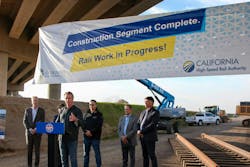The California High-Speed Rail Authority (CHSRA) and Cascadia High-Speed Rail projects are making progress, advancing into the next phases of construction and planning.
CHSRA begins first steps in preparing for track and systems construction
Elected officials, stakeholders and project partners gathered to kick off CHSRA’s Railhead Project in Kern County, Calif., marking the first steps in the track and systems construction process. The substantial completion of Construction package four (CP 4), the southernmost segment of construction in the Central Valley, paved the way for the next phase of the project.
“No state in America is closer to launching high-speed rail than California – and today, we just took a massive step forward,” said California Gov. Gavin Newsom. “We’re moving into the track-laying phase, completing structures for key segments and laying the groundwork for a high-speed rail network. The future of transportation is being realized right here in the Central Valley with thousands of good paying jobs already created and 171 miles being worked on. As only California can, we’re building America’s biggest infrastructure project.”
Throughout the project, CHSRA has been working closely with Brightline West and the High-Desert Corridor Joint Powers Agency to support a southwest regional high-speed rail network. The entities have been ensuring coordination of technical and operational significance to create an interoperable system that connects riders to and from Las Vegas to California’s high-speed rail system in Southern California.
“Today we’re recognizing the system’s progress and looking ahead as we advance important partnerships and track work that moves us closer to operations while putting Californians to work,” said CHSRA CEO Ian Choudri. “We’re committed to working collaboratively and ultimately developing a modern, interstate high-speed rail network that will not only boost ridership in the Southwest part of the country, but bring to the forefront the possibility of delivering high-speed rail benefits sooner.”
The Railhead Project begins the next phase of the high-speed rail program and is necessary for CHSRA to receive materials to start construction of temporary freight tracks, which includes delivery of major equipment such as track laying machines, track crossties, traction power and overhead contact systems (OCS). The work starts with a period of subgrade preparation, readying the site for the eventual laying of ballast ties and rail for the yard, effectively serving as a location to receive materials required to build the high-speed rail track. CHSRA notes it will be issuing a request for proposals to procure a contract for track and OCS construction in 2025.
About CP 4
CP 4 is a 22-mile stretch of the high-speed rail project between Poplar Avenue in Wasco and approximately one mile south of the Tulare/Kern County line. CHSRA contracted with California Rail Builders to construct all high-speed rail structures located within this segment, which includes 11 civil structures comprised of overpasses, underpasses and viaducts built to take high-speed trains over roadways, waterways and existing rail lines. Of the more than 14,500 construction jobs created since the start of the high-speed rail project, work in CP 4 generated more than 3,200 jobs that went to residents of the Central Valley, the majority going to workers in Kern County, according to CHSRA.
In California’s Central Valley, there are 25 active construction sites, more than 60 miles of guideway completed and nearly five miles of bridges and other structures in place, making it possible to begin the track laying construction process. In addition, 463 of 494 miles have been fully environmentally cleared for the high-speed rail project between the Bay Area and Los Angeles County.
Cascadia high-speed rail project receives FRA funding
The Federal Railroad Administration’s (FRA) Corridor Identification and Development (ID) Program awarded the Cascadia high-speed rail project $49.7 million for the second stage of planning. The project plans to connect Seattle to Portland, Ore., and Vancouver, B.C., in under an hour, with trains traveling up to 250 mph.
The second stage of planning for the project includes a study of potential ridership, route options and environmental considerations. It will also be coordinated with the I-5 Master Plan, allowing the Washington State Department of Transportation (WSDOT) to look holistically at highway, rail and other travel options. There will be opportunities during the process for advocates to comment on the study.
In order to advance to the second stage of planning under Corridor ID Program, the project sponsor is required to share 10 percent of the cost. WSDOT is contributing $5.6 million, which was made possible because the state passed a bill with $150 million dedicated to high-speed rail in 2022.
About the Author
Megan Perrero
Editor in Chief
Megan Perrero is a national award-winning B2B journalist and lover of all things transit. Currently, she is the Editor in Chief of Mass Transit magazine, where she develops and leads a multi-channel editorial strategy while reporting on the North American public transit industry.
Prior to her position with Mass Transit, Perrero was the senior communications and external relations specialist for the Shared-Use Mobility Center, where she was responsible for helping develop internal/external communications, plan the National Shared Mobility Summit and manage brand strategy and marketing campaigns.
Perrero serves as the board secretary for Latinos In Transit and is a member of the American Public Transportation Association Marketing and Communications Committee. She holds a bachelor’s degree in multimedia journalism with a concentration in magazine writing and a minor in public relations from Columbia College Chicago.

